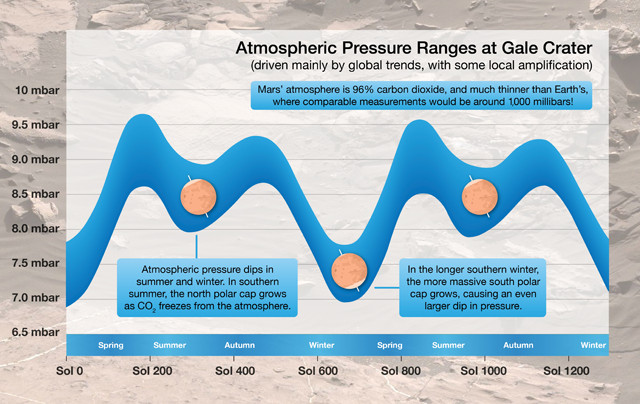
by Timothy Oleson Tuesday, September 12, 2017

Measurements by Curiosity at Gale Crater over two Martian years show that the highest atmospheric pressures on Mars occur during southern hemisphere spring and autumn (northern autumn and spring, respectively). Credit: NASA/JPL-Caltech/CAB(CSIC-INTA).
The 2020 window represents an especially good opportunity for missions looking to reach the Martian surface because of favorable environmental conditions on the planet early in 2021 when the spacecraft will arrive. The elliptical shape of Mars’ orbit means that the planet is, at times, much closer to or farther from the sun, so the amount of sunlight hitting the planet varies dramatically through the Martian year. Meanwhile, the tilt of Mars’ axis, as on Earth, leads to a progression of seasons as the orientations of the northern and southern hemispheres with respect to the sun change regularly and oppositely. The combination of Mars’ orbit and tilt drives an annual cycle of swings in atmospheric pressure of up to about 25 percent as carbon dioxide freezes out of, or sublimes into, the atmosphere.
Because the timing of optimal launch windows every 26 months isn’t synced with the Martian year, which lasts 687 Earth days, conditions on the planet when spacecraft arrive vary from one launch window to the next. Compared to when Curiosity arrived in 2012, for example, the Martian atmosphere will be 10 to 15 percent more dense when spacecraft arrive in 2021 amid the northern hemisphere spring, says Allen Chen, the entry, descent and landing phase lead for NASA’s Mars 2020 rover. Current systems designed to slow spacecraft as they approach Mars rely heavily on atmospheric drag. “More atmospheric density gives us more stopping power,” he says. Overall, “the 2020 opportunity gives us a favorable balance of relatively high atmospheric density and little to no risk of dust storms, making it an excellent time to go to Mars.”
© 2008-2021. All rights reserved. Any copying, redistribution or retransmission of any of the contents of this service without the expressed written permission of the American Geosciences Institute is expressly prohibited. Click here for all copyright requests.